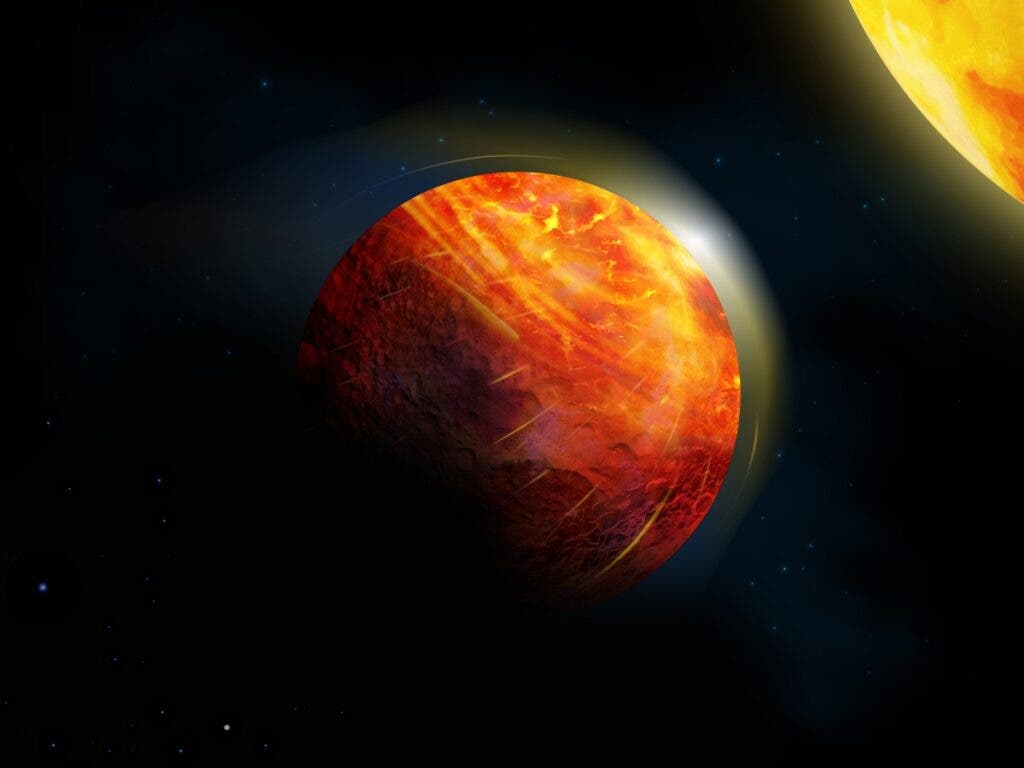
With its clouds of sulfuric acid and surface temperatures exceeding 400 degrees Celsius, Venus is often referred to as a sort of incarnation of hell. It could be worse, though. In a new study, astronomers have zoomed in on K2-141b, a planet that is so hot it is covered in oceans of molten lava and rocks rain down from its atmosphere.
This is truly one of the most extreme worlds scientists have found out of the more than 4,000 exoplanets identified to date. In a new study, researchers from McGill University, York University, and the Indian Institute of Science Education examined the scorching planet’s atmosphere and weather system, revealing new insights about the formation and dynamics of so-called “lava planets”.
“The study is the first to make predictions about weather conditions on K2-141b that can be detected from hundreds of light-years away with next-generation telescopes such as the James Webb Space Telescope,” says lead author Giang Nguyen, a PhD student at York University
K2-141b, which is located hundreds of light-years away from Earth, owes its bizarre weather to its close proximity to its parent star. Being so close to the star also causes the planet to be gravitationally locked in its place — meaning the same side always faces the star just like the moon does Earth. As a result, two-thirds of the distant exoplanet experiences perpetual daylight, where surface temperatures 3,000 degrees Celsius (5,400 degrees Fahrenheit).
That’s so hot that rocks melt, covering the planet in a 96-km (60-mile) ocean of magma. It’s actually so hot that some of the molten rock is vaporized into the atmosphere.
On Earth, liquid water evaporates, rising up into the atmosphere where it condenses, ultimately returning to the surface in the form of rain. A similar cycle also occurs on K2-141b, only instead of water there’s sodium, silicon monoxide, silicon dioxide, and other vaporized rocky substances, which are carried by supersonic winds blowing in excess of 3,000 mph to the planet’s dark side.
In the part of the planet shrouded in eternal darkness, temperatures are frigid, hovering at -200 degrees Celsius (-424 degrees Fahrenheit). The cold atmosphere condenses the rocky substances, which rain back into the magma ocean, restarting the cycle.
However, unlike the water cycle on Earth, this rocky cycle is not in equilibrium since the flow of material from the dark side to the dayside is slower. Eventually, the researchers predict that the planet’s surface and atmospheric composition will be altered dramatically.
“All rocky planets, including Earth, started off as molten worlds but then rapidly cooled and solidified. Lava planets give us a rare glimpse at this stage of planetary evolution,” said Nicolas Cowan, a professor in the Department of Earth & Planetary Sciences at McGill University.
The findings appeared in the Monthly Notices of the Royal Astronomical Society.
https://news.google.com/__i/rss/rd/articles/CBMigwFodHRwczovL3d3dy56bWVzY2llbmNlLmNvbS9zY2llbmNlL25ld3Mtc2NpZW5jZS9hc3Ryb25vbWVycy1zdHVubmVkLWJ5LWhlbGxpc2gtd29ybGQtd2hlcmUtaXQtcmFpbnMtcm9ja3Mtb24tb2NlYW5zLW9mLW1vbHRlbi1sYXZhL9IBhwFodHRwczovL3d3dy56bWVzY2llbmNlLmNvbS9zY2llbmNlL25ld3Mtc2NpZW5jZS9hc3Ryb25vbWVycy1zdHVubmVkLWJ5LWhlbGxpc2gtd29ybGQtd2hlcmUtaXQtcmFpbnMtcm9ja3Mtb24tb2NlYW5zLW9mLW1vbHRlbi1sYXZhL2FtcC8?oc=5
2020-11-06 15:56:15Z
CAIiEH6ltosoqndLtI8i8gXZtKUqGQgEKhAIACoHCAowvvmHCzC8o4YDMMKemQY
Tidak ada komentar:
Posting Komentar